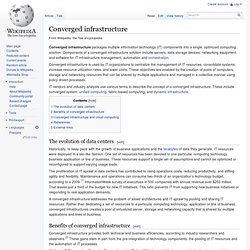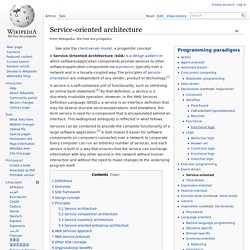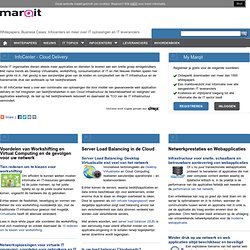

Converged Infrastructure. Converged infrastructure is used by IT organizations to centralize the management of IT resources, consolidate systems, increase resource utilization rates, and lower costs.

These objectives are enabled by the creation of pools of computers, storage and networking resources that can be shared by multiple applications and managed in a collective manner using policy driven processes. IT vendors and industry analysts use various terms to describe the concept of a converged infrastructure. These include converged system, unified computing, fabric-based computing, and dynamic infrastructure. The evolution of data centers[edit] Historically, to keep pace with the growth of business applications and the terabytes of data they generate, IT resources were deployed in a silo-like fashion.
The proliferation of IT sprawl in data centers has contributed to rising operations costs, reducing productivity, and stifling agility and flexibility. Benefits of converged infrastructure[edit] References[edit] Service-oriented architecture. See also the client-server model, a progenitor concept A Service-Oriented Architecture (SOA) is a design pattern in which software/application components provide services to other software/application components via a protocol, typically over a network and in a loosely-coupled way.

The principles of service-orientation are independent of any vendor, product or technology.[1] A service is a self-contained unit of functionality, such as retrieving an online bank statement.[2] By that definition, a service is a discretely invokable operation. However, in the Web Services Definition Language (WSDL), a service is an interface definition that may list several discrete services/operations. Comparing-the-TCO-of-PCS-VDI-DAAS-Desktone-Whitepaper.pdf (application/pdf-object) Comparing-the-TCO-of-PCS-VDI-DAAS-Desktone-Whitepaper.pdf (application/pdf-object) Cloud Delivery. Voordelen van Workshifting en Virtual Computing en de gevolgen voor uw netwerk Tien redenen om te kiezen voor workshifting Om efficiënt te kunnen werken moeten informatie en IT-resources gemakkelijk bij de juiste mensen, op het juiste tijdstip en op de juiste locatie kunnen komen, ongeacht de hardware die zij gebruiken.

Echter waren de flexibiliteit, beveiliging en vormen van beheer die voor workshifting noodzakelijk zijn, met de traditionele IT-infrastructuur gewoon niet mogelijk. Virtualisatie heeft dit allemaal veranderd. Lees in deze white paper alle voordelen die workshifting met zich meebrengt en ontdek daarnaast de 10 redenen om te kiezen voor workshifting. Netwerkoplossingen voor virtuele IT omgeving: voordelen voor gebruikers en IT managers Tegelijkertijd moeten IT managers ervoor zorgen dat de beschikbaarheid, veiligheid en prestaties van de IT omgeving worden gewaarborgd en voldoen aan de gebruikersverwachtingen. Maak kennis met Citrix OpenCloud Server Load Balancing in de Cloud. Het kennisplatform voor de IT professional. Cora-model-xl.jpg (JPEG-afbeelding, 1000x640 pixels) The CORA model. Het COmmon Reference Architecture model. Artikel Gepubliceerd: 07 april 2011 | In: Artikelen > Referentie architecturen | Door: Theo Elzinga Architectuur heeft zich ontwikkeld tot een belangrijk instrument om inzicht te verkrijgen in hoe geïntegreerde IT-landschappen met elkaar interacteren.

Door het veelvoud aan architectuurmethoden is het echter lastig te bepalen welke aanpak je het beste kan volgen. Daarnaast ontstaat er een toenemende behoefte om met behulp van een lichtgewicht aanpak snel en eenvoudig IT-oplossingen te ontwerpen. Dit lijkt misschien een niet te overbruggen tegenstrijdigheid, maar misschien is er toch een manier om dit op eenvoudige wijze mogelijk te maken. Veranderende behoeften vanuit de business hebben meer en meer invloed op de manier waarop organisaties hun IT-landschap moeten beheersen.
Enterprise architecture framework. An enterprise architecture framework (EA framework) defines how to create and use an enterprise architecture.

An architecture framework provides principles and practices for creating and using the architecture description of a system. It structures architects' thinking by dividing the architecture description into domains, layers or views, and offers models - typically matrices and diagrams - for documenting each view. Overview[edit] Enterprise architecture regards the enterprise as a large and complex system or system of systems.[2] To manage the scale and complexity of this system, an architectural framework provides tools and approaches that help architects abstract from the level of detail that builders work at to bring enterprise design tasks into focus and produce valuable architecture description documentation.
ICT Architecture - University of Saskatchewan.